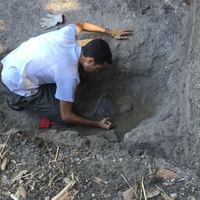
María Pilar Lapuente Mercadal
María Pilar Lapuente Mercadal received her BSc. and her PhD. degree in Geology from the University of Zaragoza (Unizar) Spain, in 1983 and 1991 respectively. From 1984 to the present develops her research activities in the Earth Sciences Faculty of Unizar, where she has been a Lecturer (full professor with permanent position) in Petrology and Geochemistry since 1999. She is currently involved in teaching Igneous and Metamorphic Petrology, and Industrial Minerals and Rocks. She was assistant lecturer in Crystallography and Mineralogy (1989-1994) and in Petrology and Geochemistry (1995-1999). During her Post-doctoral post in different British Institutions (October 1991-December 1992), awarded by the Spanish Ministry of Education and Science, she specialized in the application of Mineralogy, Petrology and Geochemistry to the study of archaeological and architectural lithic Heritage. In 1994, she received the Spanish Mineralogical Society Award for young scientists in recognition of her scientific contribution in the Applied Mineralogical Field, developed at the Research Laboratory for Archaeology, Oxford University. She has participated in several national and international Research Projects on Stone Heritage, directed several Doctoral Theses and published more than one hundred papers. She was a pioneer in Spain in the interdisciplinary study of the main ancient Hispanic quarries and their stone identification in archaeological pieces exhibited at the most important public museums. She is currently an elected member of the Executive Committee of ASMOSIA (Association for the Study of Marble and other Stones used in Antiquity), an ordinary member of several scientific societies, part of the Editorial Committee of Archaeometry and reviewer for several indexed journals.
Address: Petrology and Geochemistry, Earth Sciences Dept
Zaragoza University
Pedro Cerbuna, 12, 50009 Zaragoza (Spain)
Address: Petrology and Geochemistry, Earth Sciences Dept
Zaragoza University
Pedro Cerbuna, 12, 50009 Zaragoza (Spain)
less
Related Authors
José Ignacio Royo Guillén
Gobierno de Aragón
Kamal Badreshany
Durham University
Manuel Fernández-Götz
University of Oxford
JOSEFINA PEREZ-ARANTEGUI
University of Zaragoza
Guillermo Adrian De La Fuente
Universidad Nacional de Catamarca
Alicia María-Izquierdo
University of Zaragoza
InterestsView All (9)










Uploads
Archaeometry on marble by María Pilar Lapuente Mercadal
quality are discussed. The results also emphasise the importance of undertaking future complete archaeometric analysis of marble materials used in the sculptures of Hispania, only way to certify the provenance of the stone and, in this case, to better understand the distribution reached by the varieties of Göktepe marble in the Iberian Peninsula.
The pavement of the pool has a coating of large marble slabs whose archaeometric study indicates a Pyrenean origin, in particular from different quarries of the Saint-Béat district, alternating the banded white-grey and the yellowish colour, this latter originally from La Pène Saint-Martin, close to the village of Lez where the Brèche des Romains was exploited.
Among the materials made in this yellowish marmor, are five wall plates, crustae marmoreae, decorated with various motifs in bas-relief, of careful and excellent execution, evidence of an important specialized Aquitaine workshop of marmorarii.
de los Bienes Culturales. Bajo la perspectiva histórica, los diversos campos de actuación de los estudios arqueométricos están
recibiendo una creciente atención ya que los datos científicos obtenidos se trasladan con facilidad en información valiosa sobre aspectos como la tecnología, la datación o la procedencia de la cultura material. En el
caso particular del examen e interpretación de los restos arqueológicos pétreos, la Arqueometría se ampara en los conocimientos y técnicas propias de las disciplinas habituales en el estudio de la piedra. La identificación de su naturaleza litológica y de su lugar de origen, en definitiva de la determinación de su cantera de procedencia, proporciona
claves para interpretar el pasado. Se pretende en esta breve contribución, aportar una serie de consideraciones acerca de los estudios arqueométricos relacionadoscon el uso en la antigüedad de la piedra, con especial incidencia en el estudio deprocedencia de los mármoles romanos. Tras una primera contextualización del interés
que reporta este tipo de estudios, se detallarán los pasos que se siguen en esta investigación marcando las pautas del protocolo analítico habitual en estos estudios interdisciplinares a la vez que se expondrán algunos inconvenientes que son necesarios afrontar para llegar a la determinación de la cantera de procedencia.
(Información adicional sobre el mismo tema en Lapuente, 2014;
Lapuente et al, 2015, 2016; Lapuente y Royo, 2016).
ABSTRACT: An archaeometric and stylistic analysis of a sculptural fragment, found in the excavations of the public baths of the Caesar Augusta Colony, is carried out. The piece carved from a single block of white marble corresponds to part of the right foot of a sculpture of oversize supported, at the front until the instep, by a base of about 16 x 33 x 14 cm. The foot, nude, with the first two toes that are little more than 7 cm from the starting point, allows to suppose a statue larger than the natural of approximately 2.05 m. The remaining part of the foot rests entirely on the base, leaving a slightly raised toe, indicating that the statue could rest his weight on the right leg. The piece preserved in the Museum of the public Baths in Caesaraugusta (number 82.16.88) was sampled by removing a small chip in order to proceed to their petrographic analysis, cathodoluminescence and stable isotopes of C and O. Analytical results undoubtedly guarantee its Greek origin in the marble quarries of the Pentelic Mount in Athens. The quality of the material used along with the perfection of the sculptural work, a bare foot with toenails and cuticles perfectly suitable, allow us to reflect on the various proposals that could fit for this ideal statue.
determinar la cantera de procedencia del mármol usado. Se puntualiza la necesidad de utilizar una aproximación multi-método donde se contemplen técnicas contrastadas por diversos laboratorios, como son la espectrometría de masas de relaciones
isotópicas de C y O, y la catodoluminiscencia. Igualmente el descubrimiento reciente de canteras imperiales en Asia Menor,
lleva a desconfiar de las determinaciones realizadas anteriormente usando solo métodos tradicionales (visu y petrografía). Esta perspectiva proporciona una panorámica del trabajo realizado y del que queda aún por contrastar, a la vez que descubre la presencia de mármoles hispanos en Caesar Augusta hasta ahora no detectados. Finalmente se realiza la revisión arqueométrica de la identificación de procedencia del mármol usado en el sarcófago de Turiaso.
ABSTRACT
In this contribution, the archaeometric study of Roman sculptural marble is put into context , with particular attention in those of the Heritage of Aragon. The stages and difficulties associated with the study of the marble quarry provenance are exposed. It points out the need to use a multi-method approach where several techniques reported by different laboratories are applied, such as the mass spectrometry to determine the C and O isotopic signature and the cathodoluminiscence. Also the recent discovery of
Imperial quarries in Asia Minor, leads to doubt of the determinations previously made using only traditional methods (visu and petrography). This perspective provides an overview of the work carried out and which is yet to compare, and to discover the presence of Hispanic marbles in Caesar Augusta until now undetected. Finally, the archeometric revision of the marble identification used in the sarcophagus of Turiaso, is considered.
activities and the presence of travelling craftsmen in the Lykos Valley. Also the reuse of the Roman Imperial sarcophagi inside the Byzantine building site of the St Philip church is discussed.
For reasons unknown, local marble outcrops from the Spanish central Pyrenees were not exploited during Roman times. However a small but significant, number of archaeological pieces, mostly of white marble, were found. A combination of archaeometric techniques has been used to determine the source of the raw materials: optical microscopy, cathodoluminescence, carbon and oxygen stable isotopes. A number of pieces were carved from French Pyrenean marbles and from the Classical quarrying areas of Luni-Carrara, Paros, Proconnesos and Penteli.
is needed in order to increase better discrimination among different marble sources. after a brief exposition of the causes of this phenomenon in minerals, and in particular in carbonates, some specifications are reported in relation to the limitations and advantages
of this technique in the study of ancient marble. some examples illustrate the benefits of its application in recent studies carried out to characterize not only Phrygian-Carian marbles, but also others used in Roman times.
quality are discussed. The results also emphasise the importance of undertaking future complete archaeometric analysis of marble materials used in the sculptures of Hispania, only way to certify the provenance of the stone and, in this case, to better understand the distribution reached by the varieties of Göktepe marble in the Iberian Peninsula.
The pavement of the pool has a coating of large marble slabs whose archaeometric study indicates a Pyrenean origin, in particular from different quarries of the Saint-Béat district, alternating the banded white-grey and the yellowish colour, this latter originally from La Pène Saint-Martin, close to the village of Lez where the Brèche des Romains was exploited.
Among the materials made in this yellowish marmor, are five wall plates, crustae marmoreae, decorated with various motifs in bas-relief, of careful and excellent execution, evidence of an important specialized Aquitaine workshop of marmorarii.
de los Bienes Culturales. Bajo la perspectiva histórica, los diversos campos de actuación de los estudios arqueométricos están
recibiendo una creciente atención ya que los datos científicos obtenidos se trasladan con facilidad en información valiosa sobre aspectos como la tecnología, la datación o la procedencia de la cultura material. En el
caso particular del examen e interpretación de los restos arqueológicos pétreos, la Arqueometría se ampara en los conocimientos y técnicas propias de las disciplinas habituales en el estudio de la piedra. La identificación de su naturaleza litológica y de su lugar de origen, en definitiva de la determinación de su cantera de procedencia, proporciona
claves para interpretar el pasado. Se pretende en esta breve contribución, aportar una serie de consideraciones acerca de los estudios arqueométricos relacionadoscon el uso en la antigüedad de la piedra, con especial incidencia en el estudio deprocedencia de los mármoles romanos. Tras una primera contextualización del interés
que reporta este tipo de estudios, se detallarán los pasos que se siguen en esta investigación marcando las pautas del protocolo analítico habitual en estos estudios interdisciplinares a la vez que se expondrán algunos inconvenientes que son necesarios afrontar para llegar a la determinación de la cantera de procedencia.
(Información adicional sobre el mismo tema en Lapuente, 2014;
Lapuente et al, 2015, 2016; Lapuente y Royo, 2016).
ABSTRACT: An archaeometric and stylistic analysis of a sculptural fragment, found in the excavations of the public baths of the Caesar Augusta Colony, is carried out. The piece carved from a single block of white marble corresponds to part of the right foot of a sculpture of oversize supported, at the front until the instep, by a base of about 16 x 33 x 14 cm. The foot, nude, with the first two toes that are little more than 7 cm from the starting point, allows to suppose a statue larger than the natural of approximately 2.05 m. The remaining part of the foot rests entirely on the base, leaving a slightly raised toe, indicating that the statue could rest his weight on the right leg. The piece preserved in the Museum of the public Baths in Caesaraugusta (number 82.16.88) was sampled by removing a small chip in order to proceed to their petrographic analysis, cathodoluminescence and stable isotopes of C and O. Analytical results undoubtedly guarantee its Greek origin in the marble quarries of the Pentelic Mount in Athens. The quality of the material used along with the perfection of the sculptural work, a bare foot with toenails and cuticles perfectly suitable, allow us to reflect on the various proposals that could fit for this ideal statue.
determinar la cantera de procedencia del mármol usado. Se puntualiza la necesidad de utilizar una aproximación multi-método donde se contemplen técnicas contrastadas por diversos laboratorios, como son la espectrometría de masas de relaciones
isotópicas de C y O, y la catodoluminiscencia. Igualmente el descubrimiento reciente de canteras imperiales en Asia Menor,
lleva a desconfiar de las determinaciones realizadas anteriormente usando solo métodos tradicionales (visu y petrografía). Esta perspectiva proporciona una panorámica del trabajo realizado y del que queda aún por contrastar, a la vez que descubre la presencia de mármoles hispanos en Caesar Augusta hasta ahora no detectados. Finalmente se realiza la revisión arqueométrica de la identificación de procedencia del mármol usado en el sarcófago de Turiaso.
ABSTRACT
In this contribution, the archaeometric study of Roman sculptural marble is put into context , with particular attention in those of the Heritage of Aragon. The stages and difficulties associated with the study of the marble quarry provenance are exposed. It points out the need to use a multi-method approach where several techniques reported by different laboratories are applied, such as the mass spectrometry to determine the C and O isotopic signature and the cathodoluminiscence. Also the recent discovery of
Imperial quarries in Asia Minor, leads to doubt of the determinations previously made using only traditional methods (visu and petrography). This perspective provides an overview of the work carried out and which is yet to compare, and to discover the presence of Hispanic marbles in Caesar Augusta until now undetected. Finally, the archeometric revision of the marble identification used in the sarcophagus of Turiaso, is considered.
activities and the presence of travelling craftsmen in the Lykos Valley. Also the reuse of the Roman Imperial sarcophagi inside the Byzantine building site of the St Philip church is discussed.
For reasons unknown, local marble outcrops from the Spanish central Pyrenees were not exploited during Roman times. However a small but significant, number of archaeological pieces, mostly of white marble, were found. A combination of archaeometric techniques has been used to determine the source of the raw materials: optical microscopy, cathodoluminescence, carbon and oxygen stable isotopes. A number of pieces were carved from French Pyrenean marbles and from the Classical quarrying areas of Luni-Carrara, Paros, Proconnesos and Penteli.
is needed in order to increase better discrimination among different marble sources. after a brief exposition of the causes of this phenomenon in minerals, and in particular in carbonates, some specifications are reported in relation to the limitations and advantages
of this technique in the study of ancient marble. some examples illustrate the benefits of its application in recent studies carried out to characterize not only Phrygian-Carian marbles, but also others used in Roman times.
Petrography, isotopes, and cathodoluminescence techniques used together are effective in discriminating among the study marbles. This could facilitate the determination of the provenance of these marbles in local monuments and artifacts. However, it could be difficult to determine the marble provenances in cases where a larger set of possible provenances should be taken into consideration.
The ancient quarries of Hierapolis-Gök Dere, Marmar tepe, thiounta, Gölemezli, and Denizli have been sampled and studied. Petrography, isotopes, and cathodoluminescence techniques used together proved to be effective in discriminating among the marbles of these quarries. the study aims to provide a quick tool for provenance determination of the archaeological samples that were extensively collected from the principal monuments of Hierapolis of Phrygia. An appendix offers new data on the so-called city quarries of Aphrodisias.
of objects studied did not match with the main well-known Classical marbles but seemed to have been produced with a local stone known as
O Incio marble, which had never been yet archaeometrically analysed. Therefore, the quarries near the small village of O Incio were located and
sampled, and a multi-method approach combining polarized-light microscopy, cathodoluminescence, X-ray powder diffraction and stable C and O isotope analysis as well as spectrophotometry was applied to characterize the different outcropping marble varieties as the first and basic stepto correctly differentiate them from other Iberian and foreign marbles with similar macroscopic features.
També s'hi estudien amb detall els punts d’explotació (pedreres) i les diverses aplicacions donades a cada tipus de pedra. El llibre es va publicar com a catàleg ampliat d'una exposició amb el mateix títol muntada en el marc de la IX Asmosia Internacional Conference (Tarragona, juny del 2009).
These papers reflect the outcome of this meeting, which aimed to provide the scientific community interested in ancient stone a forum to discuss and exchange new data and results about all related aspects (geological and analytical archaeological, artistic and historical).
Following the premises of ASMOSIA, special attention is paid to a multidisciplinary approach and collaboration between researchers and practitioners from different disciplines as an essential tool to advance the identification, use, sale and use of materials tablet in ancient times.
The volume is divided into 8 chapters which are derived from sessions which organized the conference:
1. Applications to specific archaeological questions. Use of Marble
2. Provenances identification and I. Marbles
3. Provenances identification and II. Other stones
4. Transport and trade of stone
5. Quarries
6. Quarrying techniques, organization and stone manufacturing
7. Pigments of paintings and marble
8. Symbolism of stones. Local and imported materials
análisis petrológico del fragmento de "scagliola" de finales del siglo XVII custodiado en el Centro de Estudios Borjanos de la Institución “Fernando el Católico” y procedente de la iglesia de San Miguel de Borja (Zaragoza). En el texto se contextualiza la obra, se explica su técnica, se revelan los materiales que la conforman y se atribuye al artista veneciano Ambrosio Mariesque, activo en tierras aragonesas al menos entre 1688 y 1709.
piedra arenisca en el entorno de la ciudad de Huesca
fisuras y grietas; y c) biodeterioro por desarrollo de pátinas y anidamientos de aves. Su desarrollo e intensidad se ven incrementados por la conjunción de todas ellas. El deterioro afecta a la integridad de la piedra en distinto grado, según sea su ubicación y función en el paramento del edificio. Así se identificaron cuatro zonas con deterioro grave: a) el alero-canalización y desagüe del tejado, b) el óculo,
c) la cornisa-ándito y d) los pináculos.
A partir de los daños observados y su ubicación en el edificio fue posible determinar las principales causas del deterioro que, en líneas generales, se categorizan en dos modalidades: a) las asociadas a factores intrínsecos o características propias de la roca y b) las externas o relacionadas con el medioambiente y con la puesta en obra. La acción conjunta de unas y otras, maximiza los efectos lesivos.
In the framework of the project ”Petrological study of the transept of Huesca Cathedral, in its southern façade”
commissioned by the Department of Culture and Heritage of the Aragon Government to the Zaragoza University, a global characterization of the stone was carried out, with emphasis on the documentation of the deterioration state.
The diagnosis is here presented, differentiating between the identified damage and the causes that provoke them. After the visual inspection of the upper-middle of the façade, three different types of damages were recognized: a) loss of material; b) fissures and cracks; and c) biodeterioration by development of patinas and birds nesting. Their intensity and development are increased by the combination of them.
The deterioration affects the integrity of the stone in varying degrees, depending on their location and function in the face of the building. Thus, four zones were identified with serious deterioration: a) the eaves-channel drain of the roof, b) the oculus, c) the cornice-corridor and d) the pinnacles.
From the observed damage and its location in the building, it was possible to determine the main damage causes which, in general, are categorized into two types: a) the associated to intrinsic factors or stone characteristics and b) external or related with the environment and with the implementation. The joint action of all of them maximizes the detrimental
effects.
The aim of this work is the archaeometric characterization of pottery production related with five local Celtiberian production centres from the Central Iberian's Chain. In these potter's workshops dated from the third to the second centuries BC, have been made wheel's pottery grouped in three main types of vessels: storage/transport, service and table. The main goal of this research is to characterize different ceramic pastes from a mineralogical, textural and chemical point of view, with the purpose to form reference groups from each production centre and to establish the technology of manufacture. The samples have been analysed using optical microscopy (OM), X-ray diffraction (XRD), textural analysis by means of an image digitalization system and chemical analyses by inductively coupled plasma-atomic emission spectrometry (ICP-AES). The results derived have allowed the recognition of eight different ceramic fabrics. All production centres used a mud clay raw material of illite-muscovite composition with very fine natural crushed inclusions of variable lithology. With the exception of one centre, the differences showed between pastes from the same atelier may be due to different manipulation of the same raw material. The minerals phases detected and microscopic observations have permitted to estimate fire conditions for the analyzed pastes.
As part of an extended program on archaeometric research of the Celtiberian production centres situated along the Central Iberian Range, ceramic fragments of different vessel types from two selected Celtiberian workshops were analyzed: La Rodriga (Guadalajara, Spain) and Allueva II (Teruel, Spain), dated from the 3 nd to the 2 st centuries BC. The characterization was focused on the chemical analysis by Inductively Coupled Plasma-Mass Spectrometry (ICP-MS), and subjected to commonly-used multivariate statistical methods to distinguish between ceramic materials and to discriminate among different compositional groups in each production centre. The analysis was completed by performing petrographic characterization, textural observations, colour measurement and mineralogical analysis of the pieces by means of XRD. The compositional variations from major, minor and trace elements allowed to establish two subgroups in La Rodriga and one ceramic group in Allueva II. The chemical composition differences were confirmed by the petrographic characteristics and the mineralogical composition of the ceramic fabrics. These results enabled us to complete the preliminary archaeometric study in order to improve the knowledge on cultural and commercial influences in this important Celtiberian territory.
of Aquitaine origin are exposed. They are a kettle-jar and an amphorae-jar which expanded its geographical diffusion and trade routes into the Aragonese territory.